Brachialis Tendinopathy in Climbers
This season, you’ve been serious about climbing hard. You stepped up the intensity of your climbing, limited your rests days, and have created a training program to get stronger than ever. You’re noticing improvements in your climbing, but you are starting to feel a bit broken down and are developing some mild pain in the front of your elbow that worsens after a long week of training and climbing. You even notice a bit of swelling in your elbow. What should you do?
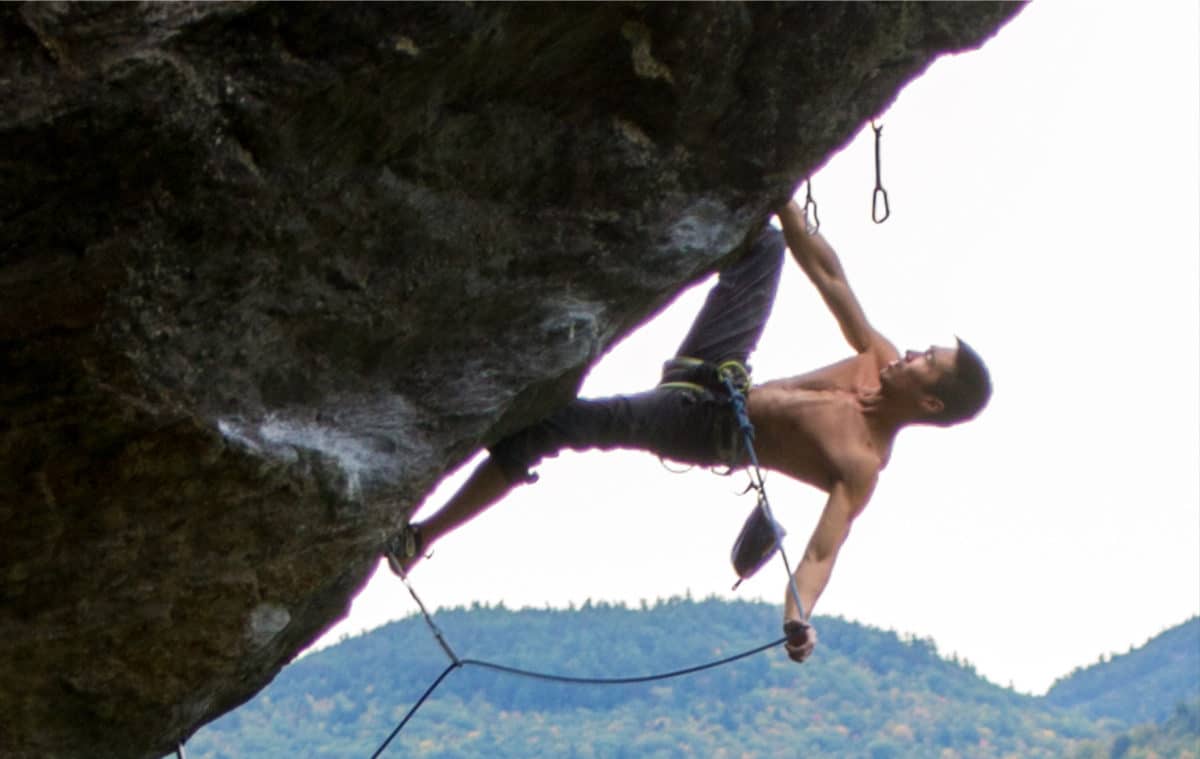
That swelling is a STOP sign. Your body is trying to tell you something, listen to it. This article will provide climbers with the tools needed to self-assess a potential cause of their elbow pain and build the framework for a conservative rehabilitation program.
Signs and Symptoms
Do you have these symptoms?
- Pain in the anterior (front) of your elbow
- Deep elbow pain
- Gradual onset of pain
- Pain after long duration of climbing
- Swelling/inflammation around the elbow
- Difficulty extending (straightening out) your elbow fully
Aggravating factors include:
- Repetitive pulling or lifting motions
- Activities that require repetitive elbow flexion (bending your elbow)
Assessment
Your signs and symptoms can be indicative of a brachialis tendinopathy. A tendinopathy injury is due to an overuse or constant loading of the brachialis tendon without adequate rest times to allow for tissue regeneration and healing. The repetitive nature of bending your elbow needed in rock climbing can lead to degeneration of the brachialis tendon that inserts into a bone in your elbow. An acute injury, typically within the first two weeks of symptoms, can be followed by tendonitis which results in inflammation. If it is a long-term injury it can result in tendinosis.
In order to set the framework to assess your injury, it will be beneficial to examine the anatomy of the arm related to your injury. There are three main muscles flex (bend) your elbow: the biceps brachii, brachialis and brachioradialis. Each muscle has different origins and insertions along the bones in your arm. By placing your hand if different positions, it can help bias one muscle over the other. Below is a chart illustrating the different origins and insertions for each elbow flexor muscle.
For the most part, climbing requires you to grip the rock with your palms facing the wall in various elbow flexion positions. Amongst the elbow flexors, it is very common for climbers to sustain brachialis tendinopathy due to the nature of rock climbing and the hand position it demands. This hand position, pronated grip (palms facing towards the wall), predisposes and isolates the brachialis to work harder as an elbow flexor than the biceps brachii and brachioradialis making it more susceptible to overuse injuries, tears and strains.
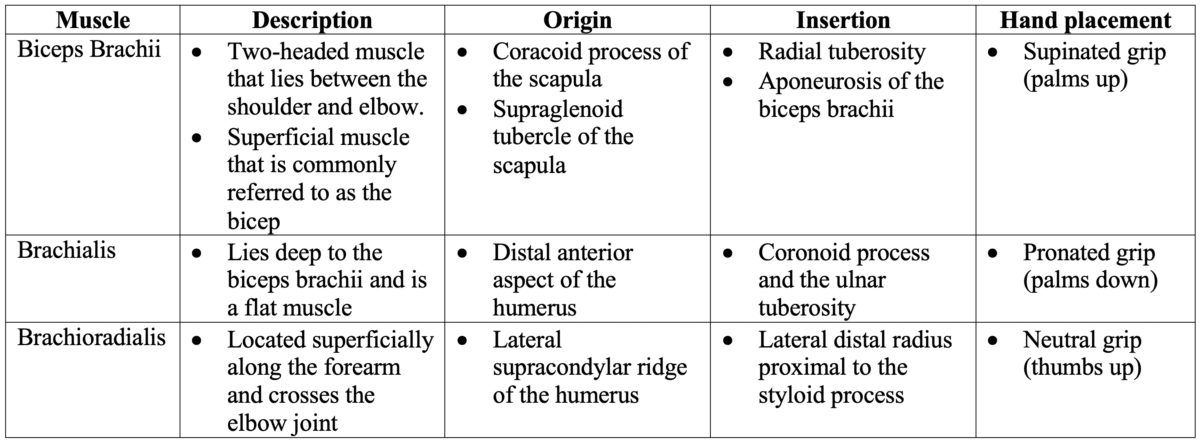
Right Biceps Brachii Muscle
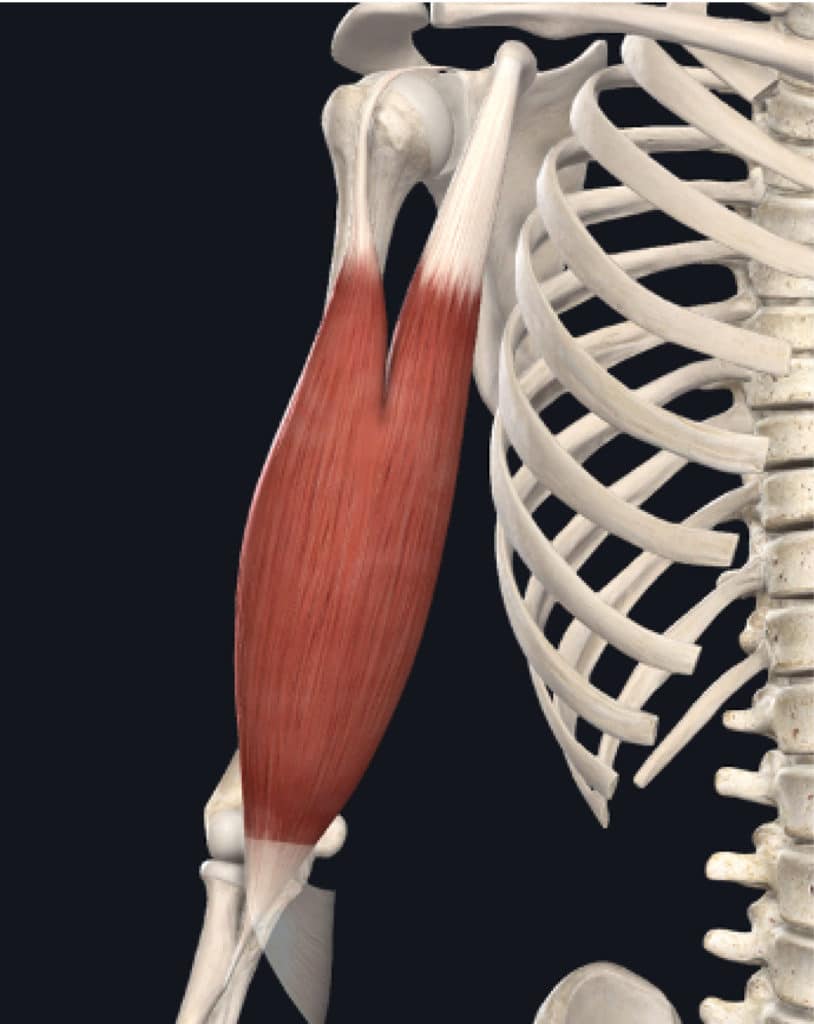
Right Brachialis Muscle
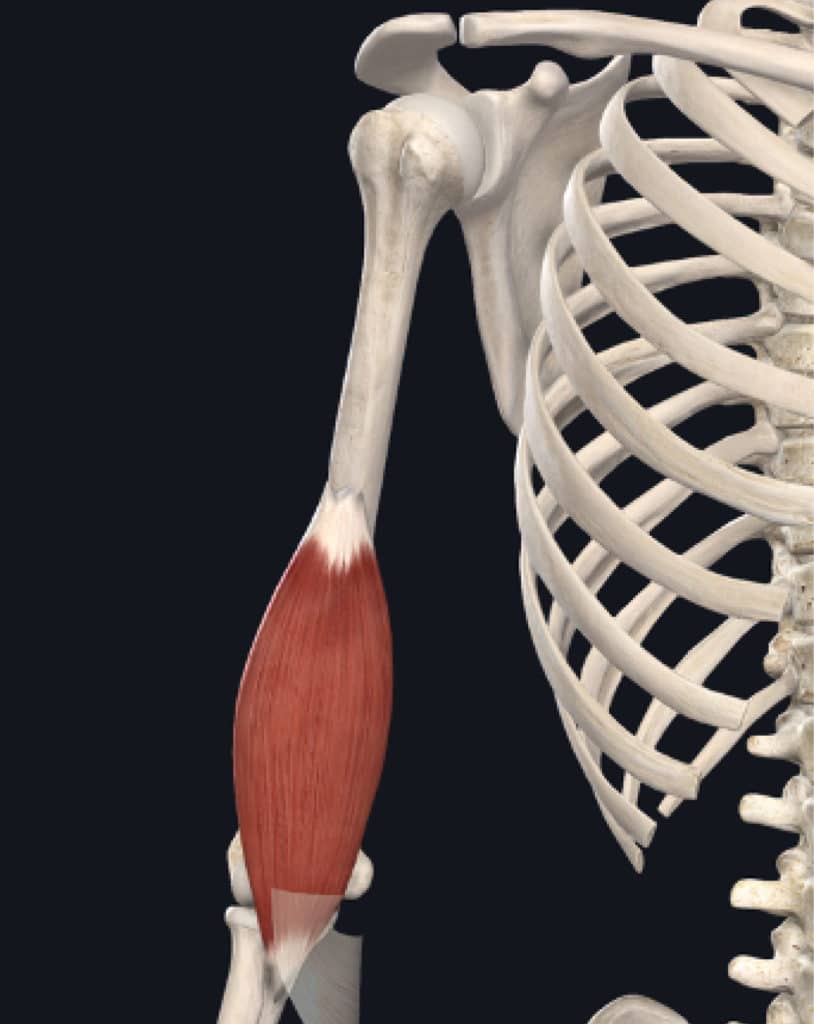
Right Brachioradialis Muscle
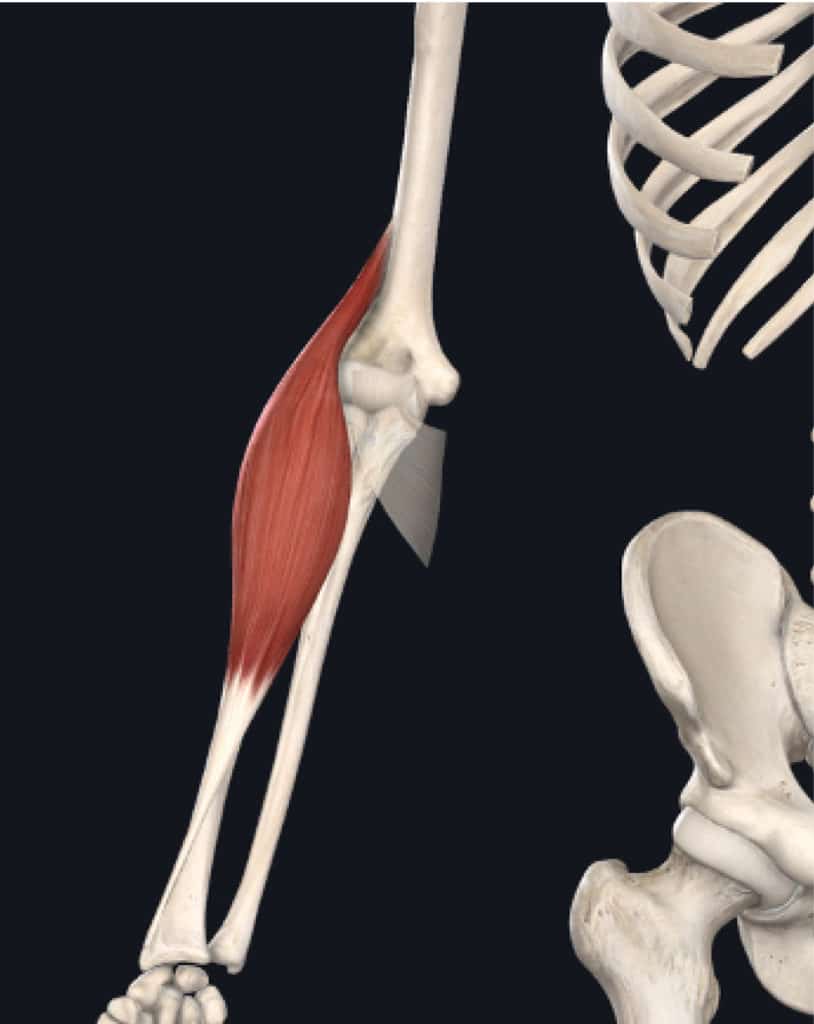
Photos courtesy of Complete Anatomy 2020
Assessing this injury will be mainly built on your:
- History
- Palpations
- Manual Muscle Tests (MMT)
History
As mentioned earlier, increased load, stress, and overuse followed by inadequate days off for recovery are hallmark signs for tendinopathy injuries. This pattern predisposes the brachialis tendon to potential degeneration and inflammation. Lastly, if you climb frequently with your arms straight and use your arms more than your legs to pull yourself up it can lead to overuse.
Palpations
You can palpate (press into) each muscle (Brachialis, Biceps Brachii and Brachioradialis) to determine which muscle is causing your pain. (Refer to the pictures below for the X to find where you should palpate for each muscle)
Biceps Brachii Palpation
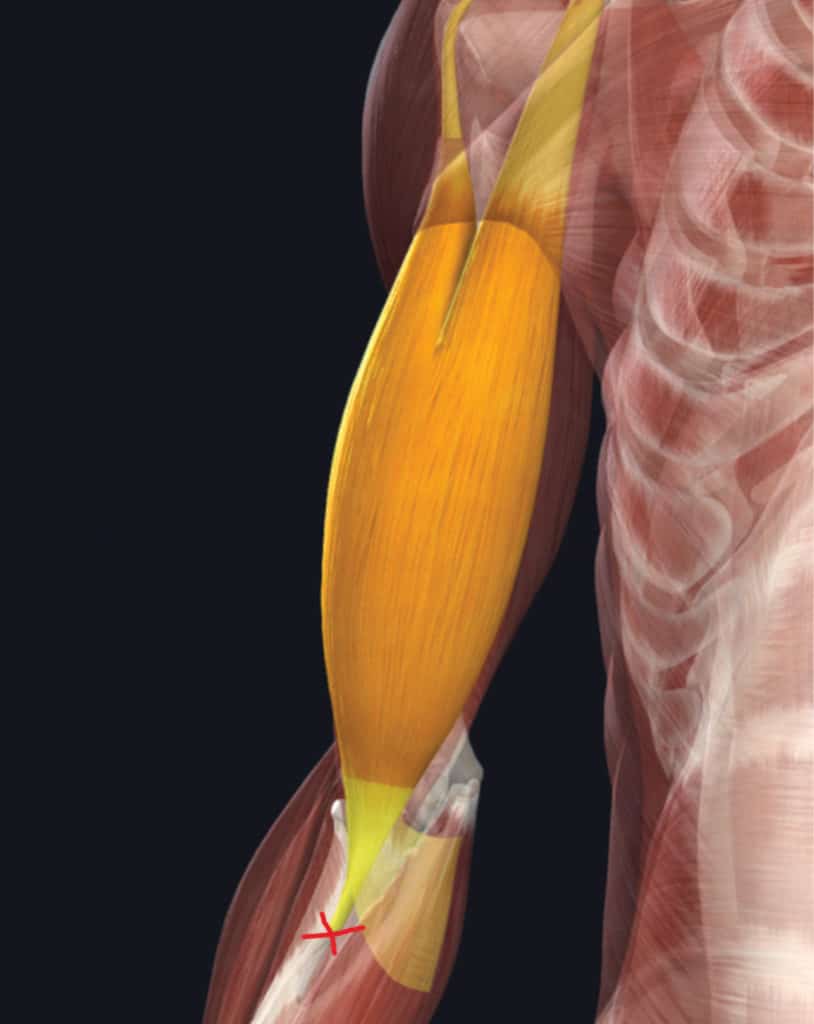
Brachialis Palpation
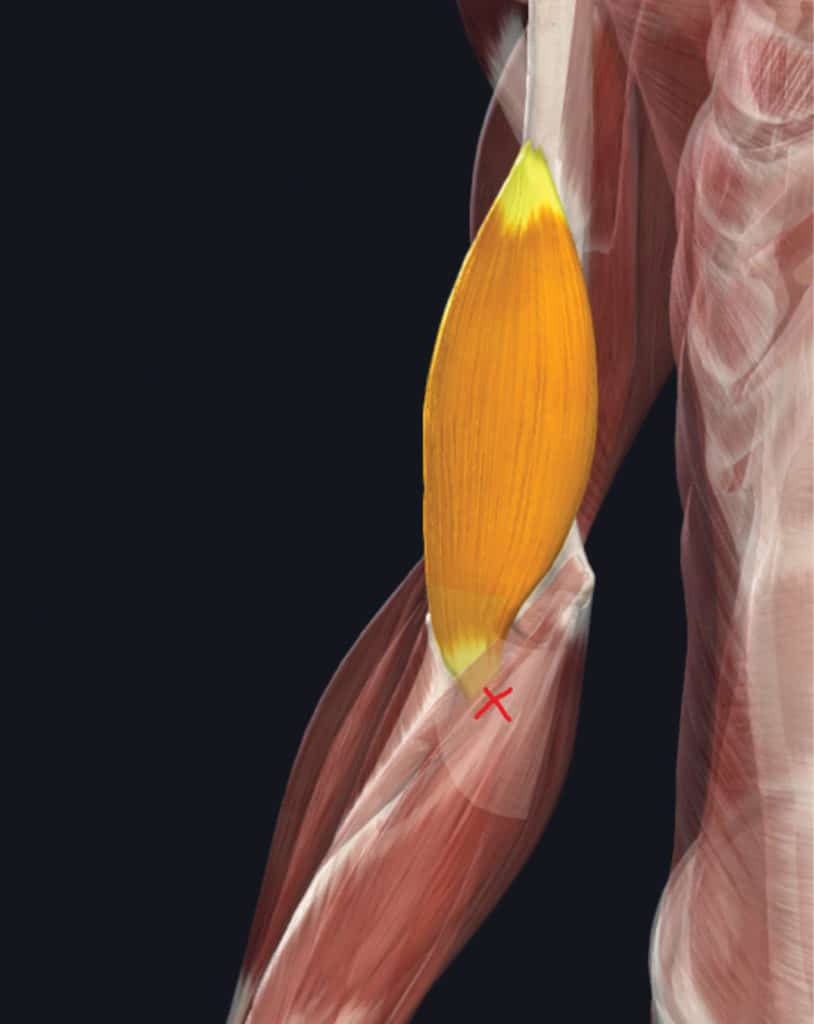
Brachioradialis Palpation
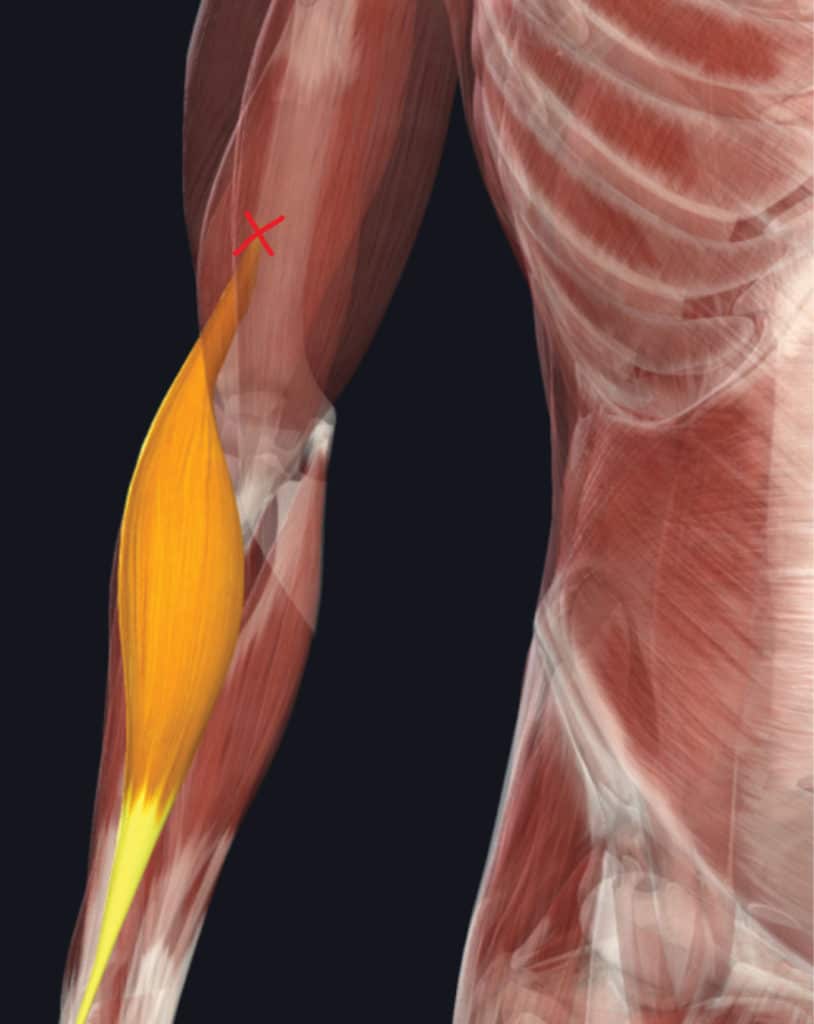
Photos courtesy of Complete Anatomy 2020
Manual Muscle Tests (MMT)
If you are able to do so, try to actively flex your elbow in the three different hand positions (supinated, pronated and neutral grip) to see if that reproduces your symptoms. A pronated grip will bias the brachialis while a supinated grip might not necessarily elicit your symptoms. From there you can try a manual muscle test of the brachialis muscle. This would be more ideal if you had a partner help you out.
Start with your elbow close by your side and a 90-degree bend in your elbow with a pronated (palm downward) grip. Have your partner support the bottom of your elbow and the other hand on top of your wrist. Your partner will push down on your wrist trying to straighten out your arm. Note if this elicits your symptoms. If it does, the brachialis muscle can be the main player in your injury. Perform the test again with a supinated grip (palm upward). This will bias the biceps brachii and help you differentiate. Then perform with a neutral grip (palm inward) as this may potentially bias brachioradialis.
You may also perform a modified version of this by yourself. Start with having your arm by your side and bend your elbow to 90 degrees with your palms facing down to the ground. With your other hand, apply pressure on top of your wrist as if you are trying to straighten out your arm. Perform this again but now with your palms facing up toward you and facing inward. Note if any of these hand positions reproduces your symptoms.
If your injury follows the history described above, you have tenderness/pain along the coronoid process and ulnar tuberosity, and the brachialis MMT reproduced your symptoms these all help point to the brachialis as the tissue source explaining your symptoms.
MMT of Biceps Brachii Muscle
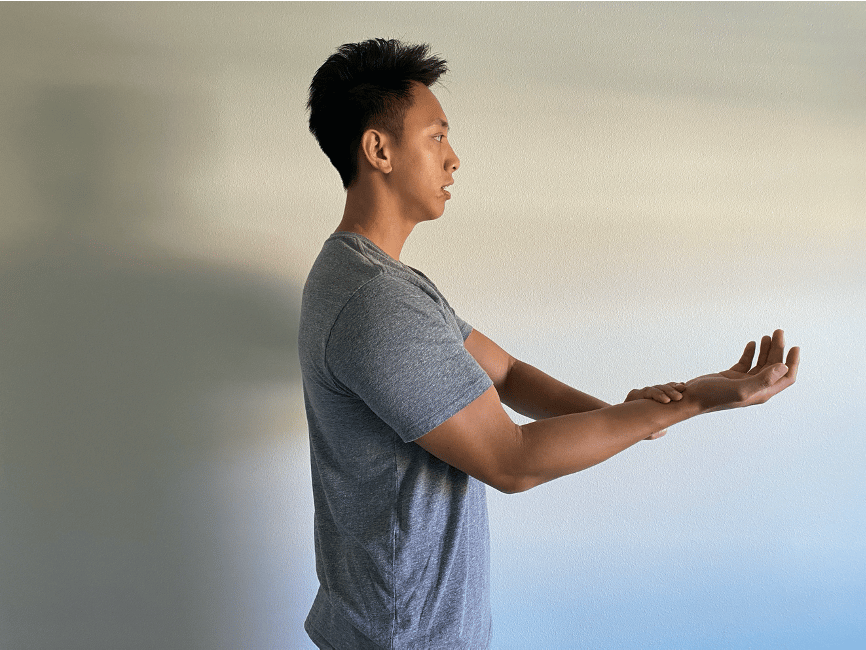
MMT of Brachialis Muscle
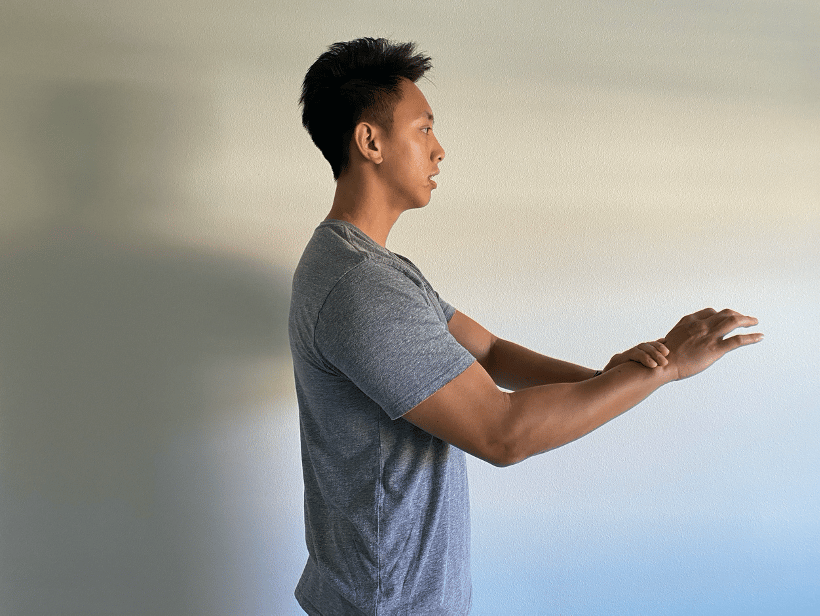
MMT of Brachioradialis Muscle
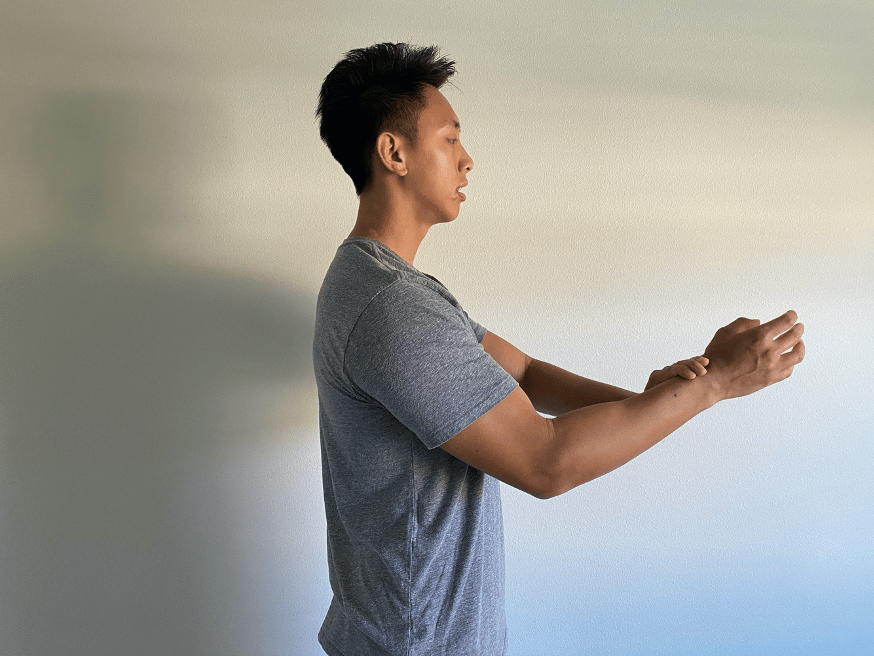
The Rock Rehab Pyramid
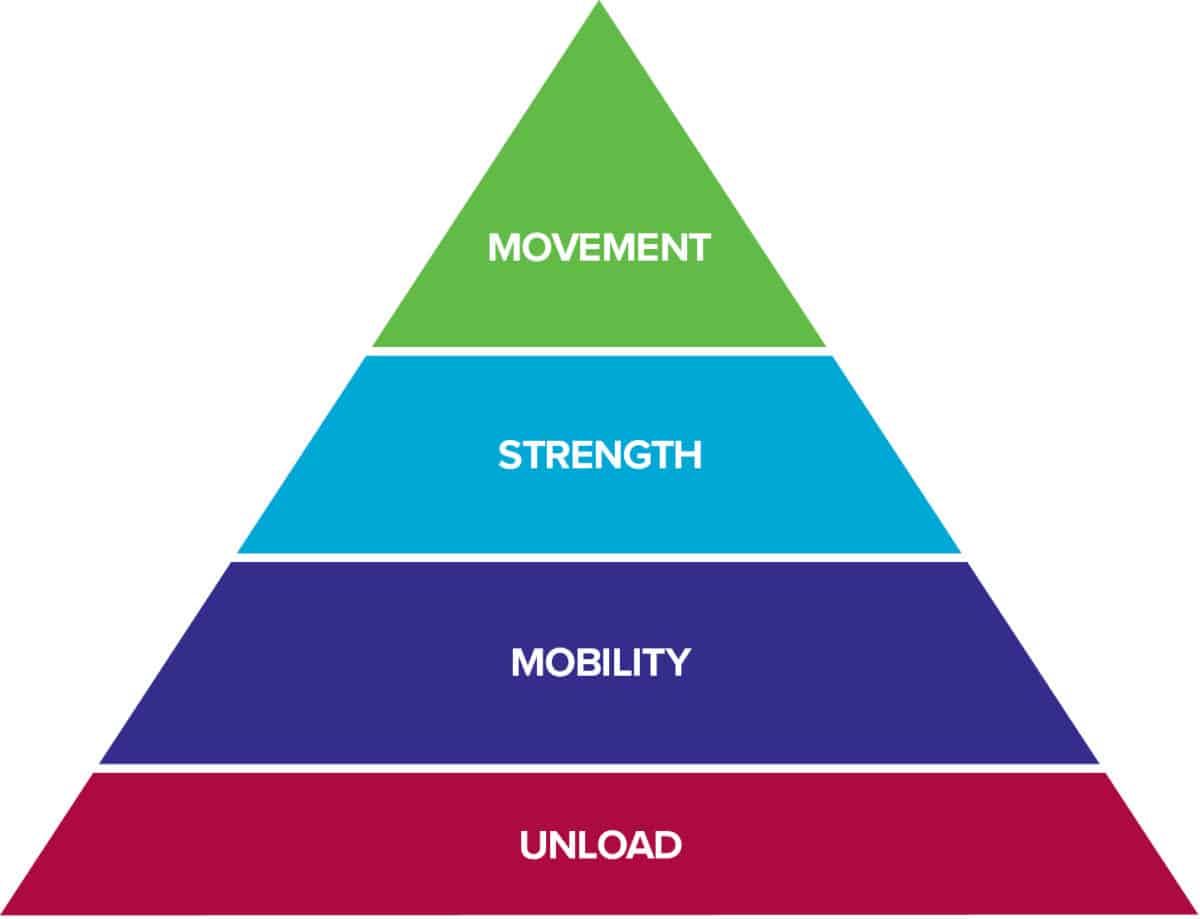
Now that you have determined your elbow pain is due to brachialis muscle overuse, let’s discuss exercises to help you manage your symptoms and ultimately get you back on the wall. In order to ensure a safe and pain free return back to rock climbing, we will be utilizing the Rock Rehab Pyramid developed by Dr. Jared Vagy illustrated in his book Climb Injury-Free. The rock rehab pyramid allows you to self-gauge your injury and when to progress to the next stage of recovery starting with the unloading phase moving to mobility, followed by strength and lastly the movement phase. This article will provide you with a 3-5 exercises in each level of recovery.
The bottom level of the pyramid aims to decrease Pain, Inflammation and Tissue Overload so that the tissues have the best healing environment. Often times, after an injury there is some sort of change in Mobility. After the tissues have calmed down from the previous level, this stage will look to reestablish normal, pain free range of motion. Once the injured area restores its mobility, it is time to increase the Strength of the surrounding muscles so that Movement in the following level can be coordinated and optimized. Click here to learn more about the rock rehab pyramid structure.
Unload
Unloading is a crucial first step in the process of rehabilitation. Imagine you are standing on a frozen lake and you notice that with each step you take, a crack in the ice gets bigger and bigger. If you continue to walk forward that could lead to a bigger break and more damage. Likewise, if you injured your brachialis tendon or any tissue from overuse/continued stressed, that tissue needs the necessary time for appropriate recovery. This involves avoiding any movements that aggravate or reproduce your symptoms.
Step 1:
- Avoid any activities that reproduce your symptoms for the first 2-3 days to allow for your tissues to rest.
- Avoid daily activities that involve repetitive lifting and carrying loads that require bending your elbow
- Stop climbing and any sport specific training such as pull ups, traversing, and fingerboarding with your elbows bent. (Note: finger boarding with your arms straight could be okay as long as it does not reproduce your symptoms)
Step 2:
- Control inflammation with ice massage to the elbow and areas of inflammation for 10-15 minutes, 2-3x/day up to 1 week after the injury.
Step 3:
- Taping or bracing your elbow to limit full elbow extension (straightening out your elbow) can prevent aggravating the brachialis more.
- Bracing will help unload the brachialis at its insertion in the elbow and offload the stress allowing the brachialis tendon to heal as well as restricting activities that can aggravate your symptoms such as repetitive elbow flexion.
Mobility
Common with overuse injuries, the tissues become more rigid and less elastic predisposing the tissues to work in unideal and inefficient conditions that can lead to further injury and compensations. The mobility phase emphasizes exercises to improve range of motion.
Wrist Flexor Stretch and Biceps stretch (1-2 minutes, 4-6x/day)
- Straighten out your arm with your palm up and bend your wrist so that your fingers are pointing to the ground. With your other hand, apply pressure onto the wrist to further bend your wrist. You should feel a moderate stretch in your forearm. If there is pain, adjust the amount you are bending your wrist so that you have a pulling sensation in your forearm that is pain free.
- If you are able to keep your arm straight during this stretch, you will also be stretching your biceps muscle which is an added bonus! Climbing is a very physically demanding sport on your forearms, particularly your wrist flexors that share a common area of insertion to your brachialis muscle. If you have tight wrist flexors or limited wrist flexion mobility that can predispose you to unnecessary stresses in the elbow.
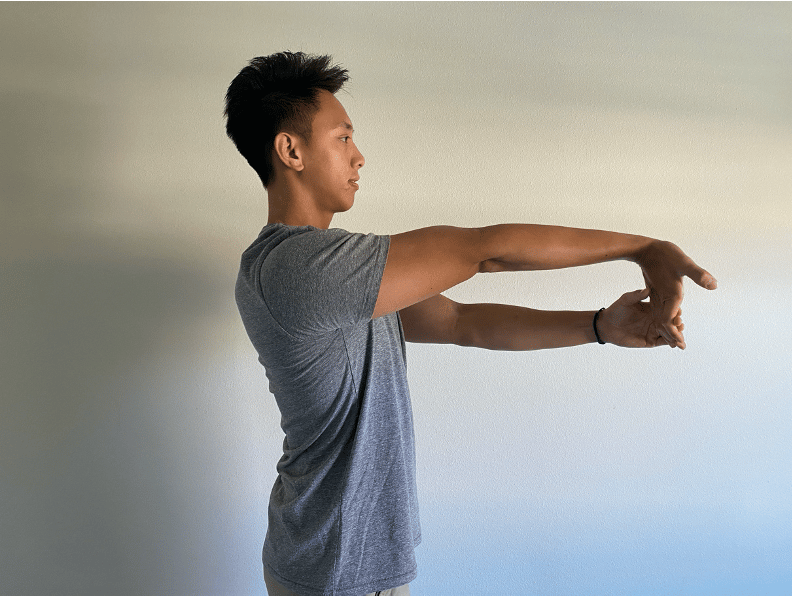
Myofascial release to the brachialis muscle with a foam roller/tennis ball/lacrosse ball
- The goal of myofascial release is loosening the fascia that can become restricted and tight allowing for more motion to occur. Utilizing a foam roller, tennis ball or lacrosse ball to areas that are tight and more tender along the brachialis muscle can help restore more motion. Note that you can vary the level of intensity by using a softer object like a tennis ball or a denser object like a lacrosse ball.
- Focus on sustained pressure and slow controlled movements to really allow for tissue extensibility. Aim for 30-60 seconds, 2-3x/day.
- If you are utilizing myofascial release for the first time or find discomfort, try applying pressure parallel to the fiber orientation of the brachialis meaning going up and down the elbow. Cross friction massages, applying force perpendicular to the fiber orientation, or in the case of the brachialis muscle, left and right, can be more aggressive and should be limited if this reproduces your symptoms or pain.
Myofascial release to adjacent structures such as the: latissimus dorsi and pectoralis major/minor
- Having tight lats and pecs could make it harder for you to raise your arms overhead and therefore make it harder for you to rock climb in overhead positions. Therefore if you are unable to adequately reach overhead, you could compensate by pulling yourself up more than you need to while rock climbing in order to finish routes as opposed to having the range of motion to reach for farther overhead holds.
Strength
Now it is time to reintroduce strength training into your program once you find you have the appropriate pain free range of motion. The goal in this phase of rehabilitation is to progressively load the brachialis muscle in order to meet the physical demands of rock climbing. As mentioned earlier, there are three primary muscles that contribute to elbow flexion including the biceps brachii, brachioradialis and brachialis. The exercises listed below all share a common goal: to strengthen your elbow flexors. By changing your hand position, you can preference a specific elbow flexor muscle. With that in mind, you will start with an exercise that minimally activates the brachialis muscle individually but still strengthens the elbow flexors as a whole and slowly introduce specific brachialis exercises.
For strength training, The American College of Sports Medicine (ACSM) recommends 8-12 reps at ~75% your 1 rep max for 3 sets. This means you should be picking a challenging weight that allows you to perform 8-12 reps. Again, let pain be your guide. If you are feeling pain or soreness, decrease the weight or regress back one level on the pyramid.
Isometric bicep (elbow flexion): 5-10” holds x 10 reps per hand.
- Isometric exercises are great to start off with first in a strength rehabilitation program because it allows you to contract your muscles without changing the length of the muscle decreasing the risk of injury.
- Find a table, ledge, or something stable you can place your hand under while maintaining an upright posture and ideally 90-degree bend in your elbow. Place your hand underneath that stable object with your palm facing up towards the ceiling and press into that object while maintaining that great posture and 90-degree bend in your elbow for 5-10 seconds and slowly release after each rep.
- To make the exercises more challenging and specific to your injury, progress to a thumbs up hand position (neutral grip), followed by a palm down (pronated) hand position. We will be utilizing these various hand positions in subsequent exercises.
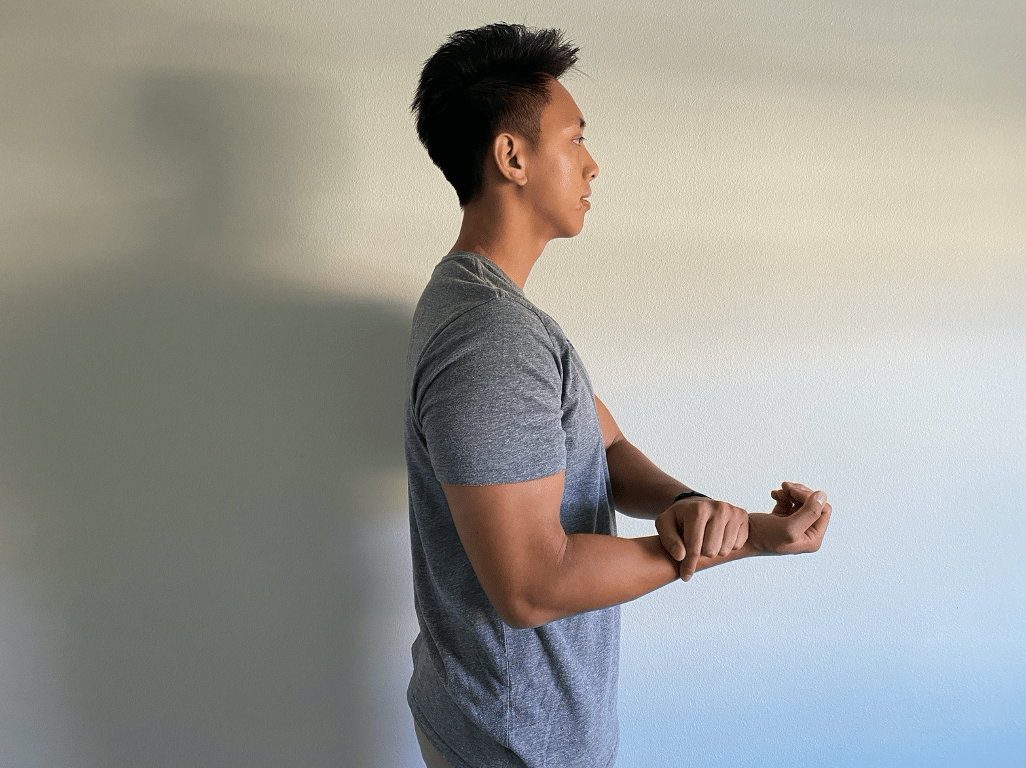
Supinated dumbbell (DB) bicep curls: 8-12 reps x 3 sets.
- Begin standing with an upright posture, scapulas retracted (shoulder blades squeezed together), elbows at your side and your palms facing up. Perform a DB curl ensuring full range of motion and a slow controlled manner on the way down to starting position.
- With a supinated grip, this will bias your biceps brachii muscles as a primary elbow flexor while your brachioradialis and brachialis are still functioning but not to the same degree as the biceps brachii.
Hammer grip DB bicep curls: 8-12 reps x 3 sets.
- Starting in the same position as the supinated DB curls, this time turn your hands so that your thumbs are pointing up to the ceiling.
- With a hammer grip, this will put more bias on your brachioradialis muscle, and more recruitment of the brachialis muscle compared to the supinated grip position.
Pronated grip DB bicep curls
- Starting in the same position as the previous two exercises, this time turn your hands down so that your palms are facing the ground.
- With a pronated grip, this will place the most bias on the brachialis muscle and optimize its recruitment as an elbow flexor.
- To make this exercise harder and more task specific to climbing you can move your elbow starting position forward 45 degrees away from your body to replicate moving your elbow in a more extended position and increase the demand on the brachialis muscle.
Eccentric Focused pronated grip DB bicep curls
- Now that you have utilize the pronated grip DB curls it is time to add another variability to the exercise, an eccentric focused component. Studies show that by exposing tendons to an eccentric load places more demand on the tissues than concentric loads (focusing on shortening the muscle, in this instance the going down portion of the DB curl).
- Perform the same exercise #4 but this time take 3-5 seconds when lowering the weight to the starting position. In order to focus more on the eccentric aspect of the exercise, use your other hand to assist you to bring the DB back up to the starting position to avoid fatigue.
Movement
The final stage of rehabilitation is to reintroduce goal-oriented movements and challenge the brachialis muscles in tasks that more resemble rock climbing. In this phase we will focus on a foundational body-weight exercise, the pull up, in various forms to start to load the elbow flexor muscles in movement patterns you want to get back to. Once you have established a strong foundational pull up, you are ready to take your training to the next level! Try these exercises on hang boards and rock climbing holds to reintroduce climbing specific grips and an grip strengthening.Movement
Scapular pull ups: 8-10 reps (1-2” holds) x 3 sets
- Before we start loading the brachialis directly, it has been some time since you have been doing pull ups or body weight exercises so let’s take the time to reinforce good scapular mechanics and slowly reintroduce bodyweight training.
- Start by hanging on a bar with your hands a little wider than shoulder width apart and palms facing away from your body. From a dead hanging position, draw your shoulder blades down and in. Imagine you are trying to hold a pencil at the bottom of your shoulders blades by squeezing them together. Hold this position for 1 second and slower lower back down to a dead hang position.
- This exercise will help promote ideal shoulder blade mechanics during pulling motions and shoulder integrity so you can keep on climbing.
Isometric pull ups with pronated grip: 3-5 second holds x 10 reps
- Start by hanging on a bar with your hands shoulder width apart and palms facing towards you. Perform a pull up to about a 90-degree bend in your elbows and hold for 3-5 seconds. Slowly lower yourself back to starting position. Remember to keep your core engaged throughout the exercise.
- With a pronated grip, this will preferentially target the brachialis muscle against bodyweight.
- Isometrics exercises may not seem as fancy as regular pull ups, but they have an immensely valuable contribution to rock climbing. Isometric movements are seen every time you test a rock hold and lock out, mid move trying to attach the next quick draw or resting from a huge forearm pump three quarters up a route.
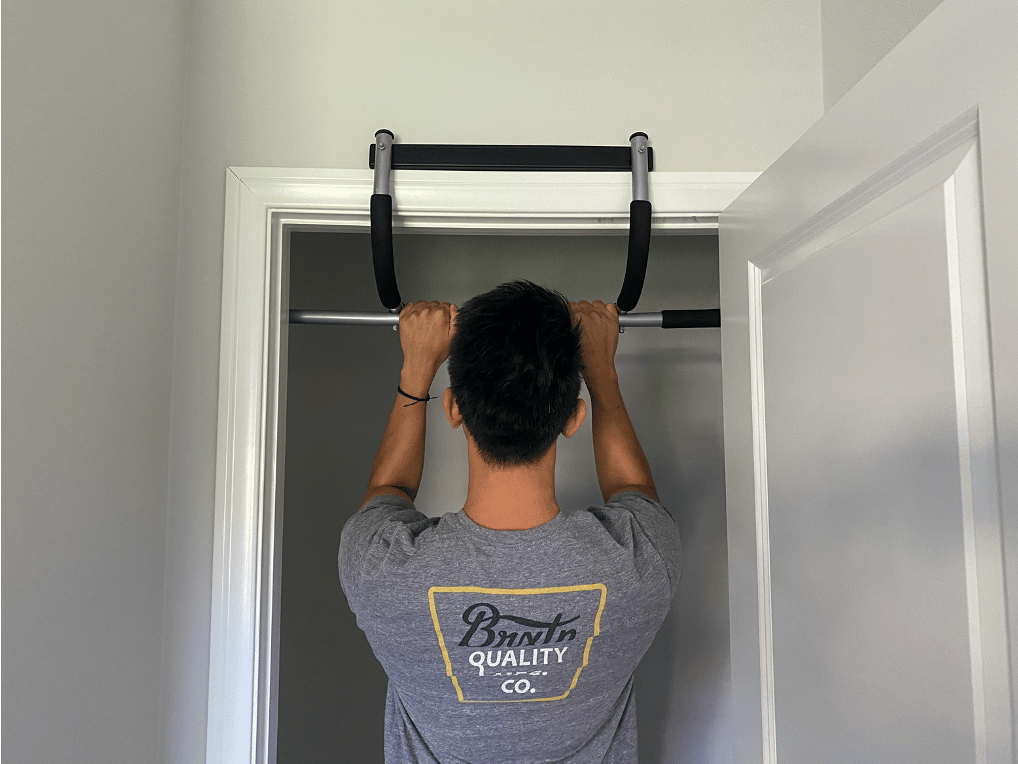
Eccentric focused pull up with pronated grip: 8-12 reps x 3 sets
- Like the previous exercise (Isometric pull ups), you will start and perform the same movement but now this time through a full range of motion and focus more on the lowering portion of the pull up taking about 3-5 seconds coming back to starting position.
- By training with an eccentric focus, this will place a larger demand on your muscles than concentric focused movements and challenge you to control your body as you slowly lower yourself.
- Like the previous strength based eccentric exercises, if you are fatiguing before the 8-12 rep range, you can reset after each rep and jump back to the starting position to purely focus on the eccentric portion of the exercise.
Isometric pull ups: 3-5 second holds x 10 reps
- Similar to isometric pull ups, except now with your hands a little wider than shoulder width apart.
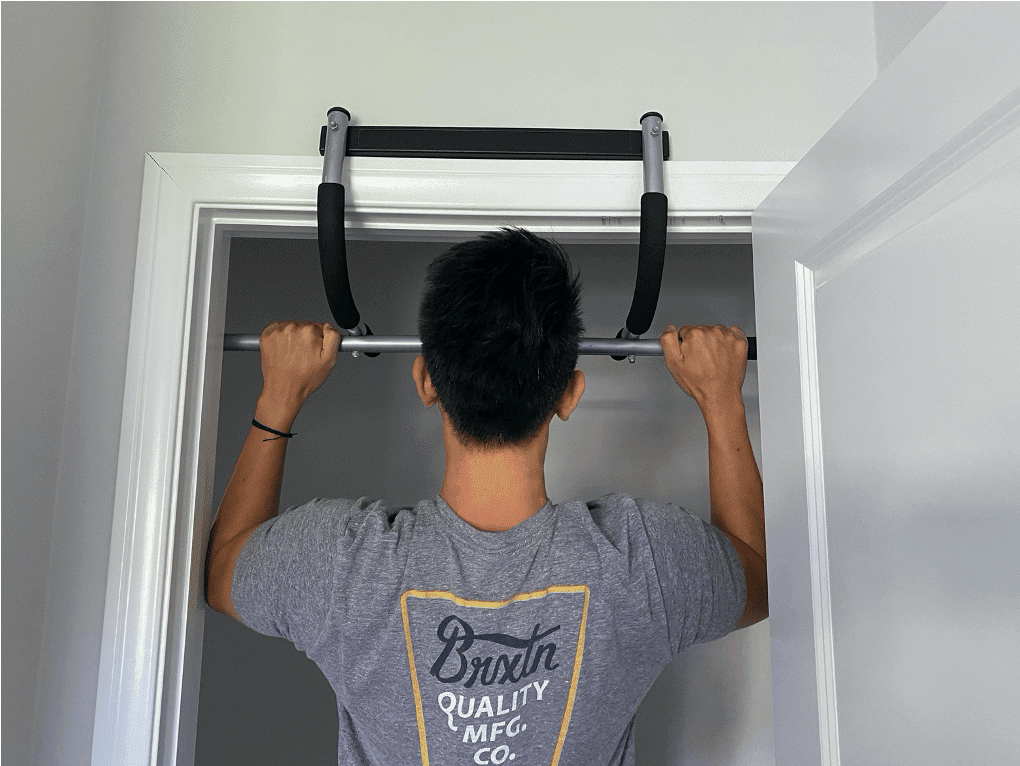
Eccentric focused pull ups: 8-12 reps x 3 sets
- Similar to eccentric focused pull up with pronated grip, except now with your hands a little wider than shoulder width apart.
When to See a Medical Practitioner
This article is provided to be a framework to help you navigate your potential injury and illustrate the fundamentals to begin your road to recovery. You can take the next to injury prevention and rehabilitation by seeing a physical therapist. Physical therapists are trained and specialized in movement analysis, building individualized therapeutic exercise programs and manual interventions to enhance and improve your recovery process to get you back to rock climbing.
About the Author
My name is Kurt Vo and I am a second year Doctor of Physical Therapy (DPT) student at Mount Saint Mary’s University (MSMU) in Southern California. I am an avid backpacker and enjoy spending my time outdoors hiking, camping and playing beach volleyball. This is where I found my passion for rock climbing and was introduced to the equally challenging and rewarding sport of rock climbing.
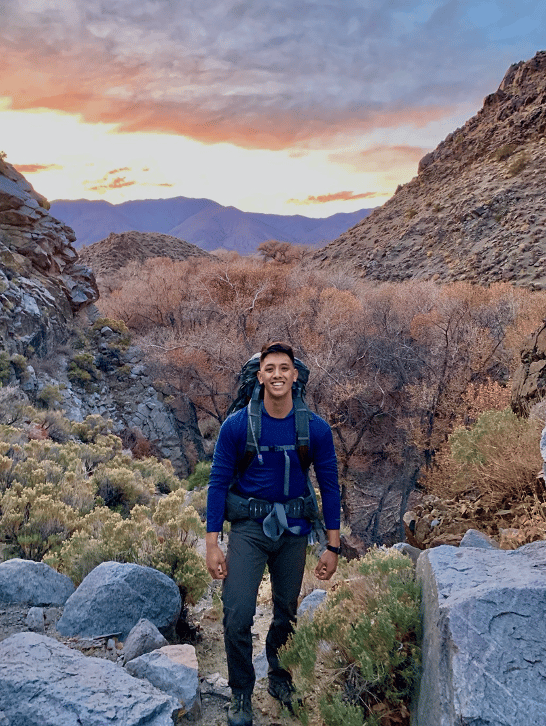
If you have any questions, please feel free to contact Kurt via email below.
kurtvo@msmu.edu
References
- “Bicep Tendon Pathology.” Orthopedic Rehabilitation Clinical Advisor, by Derrick Sueki and Jacklyn Brechter, Mosby, 2010, pp. 420–423.
- “Biceps Brachii.” Physiopedia, physio-pedia.com/Biceps_brachii.
- Bollen, S R. “Soft Tissue Injury in Extreme Rock Climbers.” British Journal of Sports Medicine, vol. 22, no. 4, 1988, pp. 145–147
- “Brachialis.” Physiopedia, www.physio-pedia.com/Brachialis.
- “Brachioradialis.” Physiopedia, physio-pedia.com/Brachioradialis.
- Frick, Matthew, and Naveen Murthy. “Imaging of the Elbow: Muscle and Tendon Injuries.” Seminars in Musculoskeletal Radiology, vol. 14, no. 04, 2010, pp. 430–437.
- Miller, Jeffery. “Climber.” Dynamic Chiropractic – Chiropractic, News, Articles, Research & Information for Chiropractors – Find a Chiropractor, 1 Jan. 2013, www.dynamicchiropractic.com/mpacms/dc/article.php?id=56297.
Peterson, Charles, and Anthony Ceraulo. “Caring for Climbers.” Current Sports Medicine Reports, vol. 14, no. 5, 2015, pp. 397–403
“Tissue Injury and Healing .” Orthopedic Rehabilitation Clinical Advisor, by Derrick Sueki and Jacklyn Brechter, Mosby, 2010, pp. 3–17.
- Disclaimer – The content here is designed for information & education purposes only and the content is not intended for medical advice.


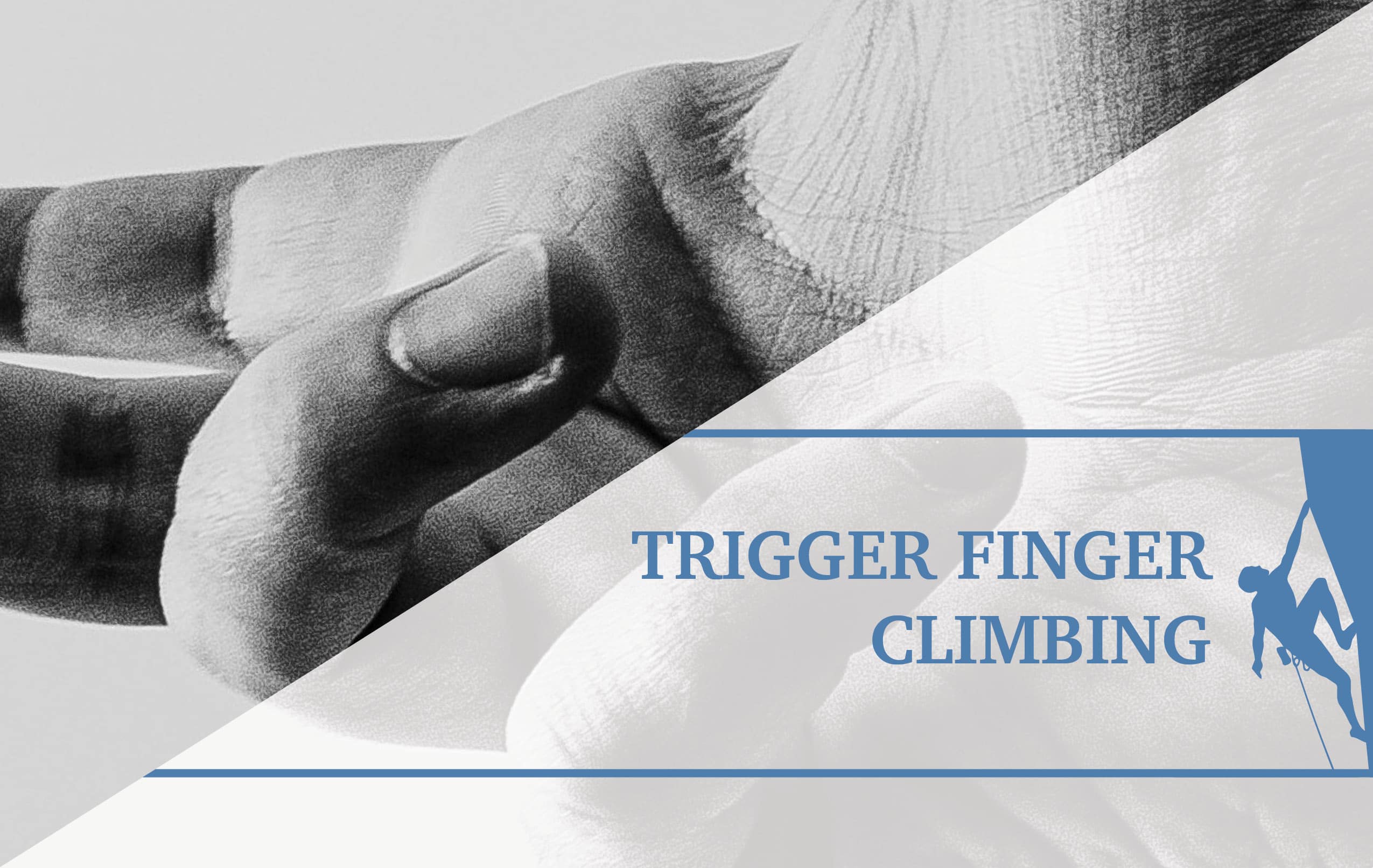
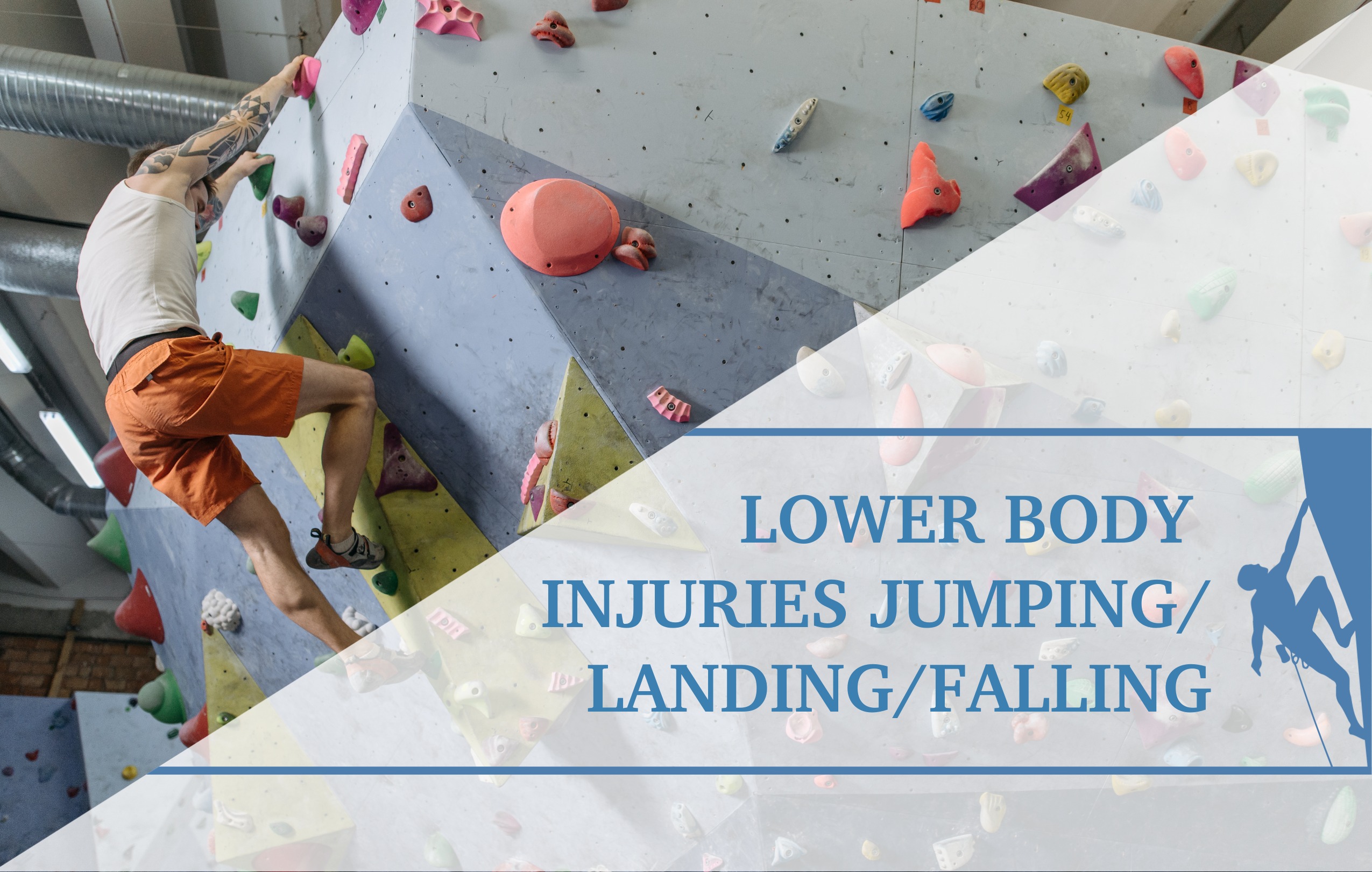
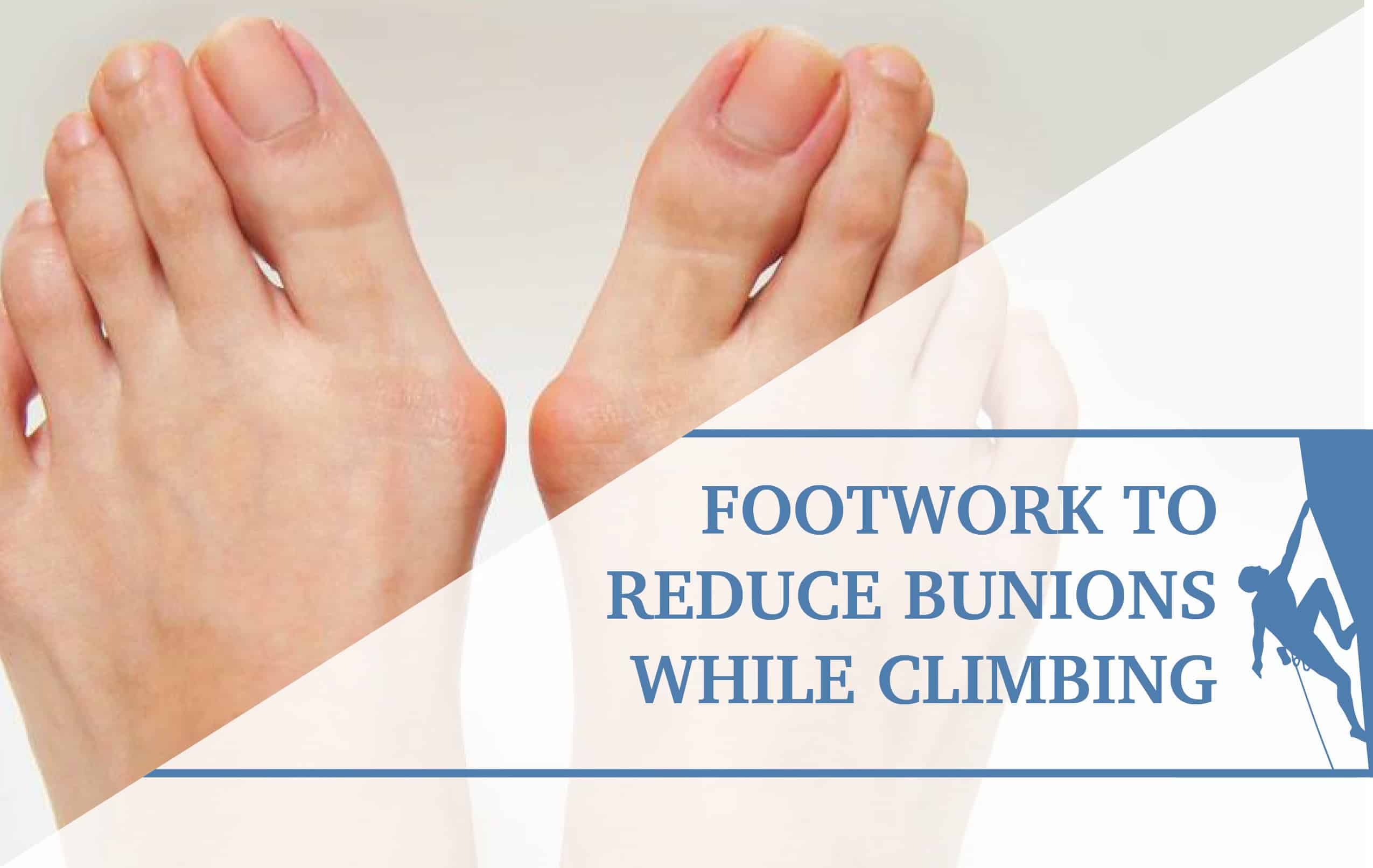
Thanks for the well-written article! How often should the strengthening exercises be done?
Strength exercises can be performed up to 3 times per week. Hope that helps clarify.
Thank you so much for this article! As someone who has just started sport climbing and is struggling with this issue right now I plan to follow the framework you have outlined. Question: How long should I engage in the strength exercises before returning to the climbing gym?
Hey Ryan,
The amount of time to perform the strength exercises is variable baed on the individual. For high grade injuries, it is important to remember that it takes 6-8 weeks for the body to develop strength, so you can use that as your guide. However, for climbers with low grade injuries, they can typically return to climbing within 2-3 weeks of strength work because of the neurologic adaptations.
Excellent article!
Should movement be performed at the same frequency as the strength exercises too (3x per week)?
Yes, the movements can be performed at the same frequency as the strength exercises.
thanks for such a great article – following your diagnosis photos i have injured my brachioradialis. do the exercises you have posted also work for this?
Hey Nigel,
Yes, they will work for Brachioradialis, but just perform in a neutral grip to target that muscle.
Should movement and strength exercises be performed on the same day?
Hey Alex,
Yes, you can perform them on the same day. But it is recommended to first be able to complete all of the strength exercises first and wait a day to make sure their is no pain or soreness leading into the next day, and then you can perform both strength/movement in the same day after that.
Hi,
Thanks for the article, very informative! How do you know when it’s okay to start strength training after mobility? I think I’ve injured my brachialis and am stretching but I can still feel the injury (not painful as such) if i engage the muscle eg pulling a window down. Thanks!!
Typically 4-6 weeks of a soft tissue injury (such as Brachialis Tendinopathy) is a safe time range to begin strength training since the muscle and tendon unit have had adequate time to remodel and recover. However, this various based on the individual and it is recommended to see a Doctor of Physical Therapy to help make the judgment of when to transition. For example, after a clinical exam, I often have patients start resistance training at low loads as early as one week after the onset of tendinopathy – but the clinical exam (and injury history) help guide that decision making process.
I first started noticing elbow and forearm pain while trying to do pull-ups in January of 2020 after having had a digital (finger) nerve repair surgery the previous September that had resulted in another injury that fall to my shoulder when I was doing a set of squats and the bar fell off the shoulder of my injured hand, resulting in a frozen shoulder. All of that limited my ability to work out for several months and weakened me. I had always worked out very hard. When I attempted to return to working out, I tried to resume at my previous level of intensity. That was probably a bad idea in retrospect.
I could not pinpoint where the pain was coming from. It alternately felt like it was coming from deep within the front side of my elbow, the top of my forearm, and the outside of my arm above the elbow.
Once the pandemic hit, I could no longer go to the gym and became weaker and weaker. Every time I had the opportunity to work out, I felt very noticeable pain in all of the areas mentioned. I tried resting it for long periods. When I tried to resume working out at home (intensely again), the pain came right back. I figured the pain was due to the nerve repair surgery somehow damaging the nerves in my arm. There was also noticeable weakness in my forearm. It tired much more quickly than it every had before and my whole arm on the injured side was much weaker than my other arm. It had previously been my strong arm. A nerve conduction study found that I have pinched nerves coming out of my C5 and C6 vertebrae which feed into my arm on the injured side.
It wasn’t until I saw a pain management doctor recently who suggested I have tennis elbow that I began considering that possibility. As I researched it more, I realized what I likely have is a strained brachialis tendon – perhaps also a strain of the brachioradialis tendon.
My question would be, given the length of time this has all been going on, would the course of rehab you have laid out in this blog article be a wise course to embark upon? Also, are you an advocate of the gelatin/vitamin C supplementation regimen to expedite healing of soft tissue injuries? (https://academic.oup.com/ajcn/article/105/1/136/4569849?login=true)
Hi Matt,
Thanks for the detailed explanation of your injury. It sounds like there a multitude of factors contributing to your injury. Because of the history of the injury, nerve conduction results, history of frozen shoulder, relationship to cervical spine, and progressive weakness I would recommend first seeing a doctor of physical therapy so they can customize a program specifically for you.
With that being said, if you would like to learn more about the potential contributing factors of your elbow condition, I recommend you check out the article below, which is a deeper dive and offers a broader scope of diagnoses:
https://strengthclimbing.com/elbow-pain-the-ultimate-guide-for-rock-climbers/
this article was very helpful. Im 90% sure that my brachialis is my issue. I recently began training for arm wrestling and I think I hurried into it too fast and got tendonopathy. Its mainly when I pronate, my forearms have been well developed from powerlifting and weighted calisthenics training, but I always avoided reverse curls and I think as a result my pronator/brachialis was underdeveloped. I don’t think the injury is severe though.
what do you think of a weeklong break from all stressful activity, with cold therapy and massages, followed by a second week of stretches and 5lb weighted movements for high repetitions ie. 30-50reps. and then week three trying to do some light but moderately intense weight training again? Would that be enough time to recover or is 4 weeks a minimum requirement?
Hey Keelan, glad that the article was helpful for you and thanks for updating on your injury. Providing personal medical recommendations is outside the scope of this article. However, I can say is that for most acute muscle / tendon injuries that a period of unloading (1-2 weeks) to allow the tissues to recover, followed by gentle range of motion and light weighted exercises, followed by a progression of greater intensity provides a typical 4 week timeframe to recover from a mild muscle strain or tendinopathy. Best of luck!
Hi I think I’ve injured my brachioradialis due to holding a bag in the hammer fist position for a long period of time. I have a slight pinch and pain when I do the hammer curl motion or holding objects. I’m starting off with the isometrics I’m just wondering how many sets of them I should do a week before trying the other variations. Thanks
The sets and reps for isometrics recommended by the article are 3x per week:
Isometric bicep (elbow flexion): 5-10” holds x 10 reps per hand.
Supinated dumbbell (DB) bicep curls: 8-12 reps x 3 sets.
Hammer grip DB bicep curls: 8-12 reps x 3 sets.
If any pain during exercises I recommend that you consult a Doctor of Physical Therapy
Great article! Thank you for the deep dive.